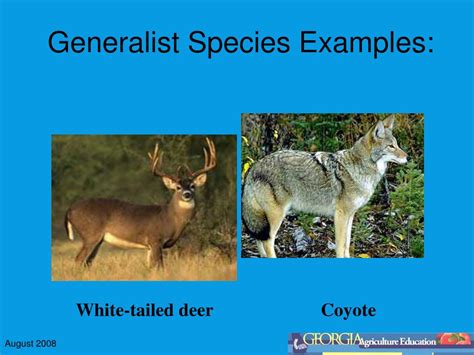The concept of generalist species traits refers to the characteristics and abilities that allow certain species to thrive in a wide range of environments and ecological niches. Generalist species are those that can adapt to various conditions, exploit different resources, and survive in diverse habitats. These traits are often contrasted with specialist species, which are highly adapted to specific environments or resources and may struggle to survive outside of their narrow niche. Understanding generalist species traits is crucial for ecology, conservation, and evolutionary biology, as these species play significant roles in maintaining ecosystem balance and biodiversity.
Generalist species exhibit a range of traits that enable their adaptability and versatility. One key characteristic is their ability to consume a wide variety of food sources. For example, the brown bear (Ursus arctos) is a generalist omnivore that can feed on berries, nuts, fish, and even small mammals, allowing it to thrive in different habitats from forests to tundras. Another important trait is their capacity for behavioral flexibility, which enables them to adjust their activities in response to changing environmental conditions. The raccoon (Procyon lotor), for instance, is known for its intelligence and dexterity, allowing it to open shells, latches, and even garbage cans, thus exploiting a wide range of food sources in both natural and human-modified environments.
Key Points
- Generalist species can thrive in a wide range of environments due to their adaptability.
- These species often exhibit dietary flexibility, consuming a variety of food sources.
- Behavioral flexibility is another key trait, enabling generalist species to adjust to changing conditions.
- Intelligence and learning capabilities can also contribute to a species' ability to adapt to different environments.
- Generalist species play a crucial role in maintaining ecosystem balance and biodiversity.
Ecological Roles and Impacts

Generalist species play critical roles in ecosystems, contributing to nutrient cycling, seed dispersal, and predator-prey dynamics. Their ability to exploit a wide range of resources means they can serve as both predators and prey, influencing population dynamics of other species. For example, the coyote (Canis latrans) is a highly adaptable predator that can feed on small mammals, fruits, and vegetation, making it a key component of many ecosystems in North America. Moreover, generalist species can act as “ecosystem engineers” by modifying their environments in ways that create new habitats for other species, such as the beaver (Castor canadensis), which constructs dams that form ponds and wetlands.
Evolutionary Perspectives
From an evolutionary standpoint, generalist species traits are often seen as advantageous in changing or unpredictable environments. The ability to adapt to different conditions can increase a species’ chances of survival and reproduction, thus favoring the evolution of generalist traits. However, this adaptability can also come at a cost, such as reduced efficiency in any one particular environment compared to a specialist species. The evolutionary trade-offs between generalism and specialization are complex and depend on various factors, including the variability of the environment, the presence of competitors, and the availability of resources.
| Species | Traits | Ecosystem Role |
|---|---|---|
| Brown Bear (Ursus arctos) | Omnivorous diet, behavioral flexibility | Predator, nutrient vector |
| Raccoon (Procyon lotor) | Intelligence, dexterity, omnivorous diet | Seed disperser, predator |
| Coyote (Canis latrans) | Adaptable diet, wide geographic range | Predator, ecosystem engineer |

Conservation Implications

The conservation of generalist species and the ecosystems they inhabit is crucial for maintaining biodiversity and ecosystem services. Given their adaptability, generalist species can serve as indicators of ecosystem health and resilience. However, their ability to thrive in a wide range of environments also means they can be involved in conflicts with human activities, such as agriculture and urbanization. Effective conservation strategies must consider the complex roles that generalist species play in ecosystems and the potential impacts of environmental changes on these species and the ecosystems they inhabit.
Management and Policy
From a management and policy perspective, understanding generalist species traits can inform decisions about habitat preservation, species reintroduction, and the control of invasive species. For example, recognizing the importance of generalist predators in controlling prey populations can lead to more effective wildlife management practices. Similarly, acknowledging the adaptability of generalist species can guide policies aimed at mitigating the impacts of climate change and habitat fragmentation on biodiversity.
What are the key characteristics of generalist species?
+Generalist species are characterized by their ability to adapt to a wide range of environments, consume a variety of food sources, and exhibit behavioral flexibility. These traits enable them to thrive in different ecological niches.
Why are generalist species important for ecosystem balance?
+Generalist species play critical roles in ecosystems, including nutrient cycling, seed dispersal, and predator-prey dynamics. Their adaptability and ability to exploit different resources contribute to maintaining ecosystem balance and biodiversity.
How can understanding generalist species traits inform conservation strategies?
+Recognizing the adaptability and ecological roles of generalist species can guide conservation efforts aimed at preserving ecosystem services and biodiversity. This includes considering the impacts of environmental changes on generalist species and the ecosystems they inhabit.
In conclusion, the study of generalist species traits offers a fascinating glimpse into the complexities of ecological adaptation and the dynamics of ecosystems. By understanding these traits and their implications for conservation and management, we can work towards preserving the biodiversity and ecosystem services that are essential for the health of our planet.
Related Terms:
- Ecological Niches
- generalist species characteristics
- Generalist species examples
- Specialist species characteristics
- Specialist species examples
- Generalist species characteristics examples


